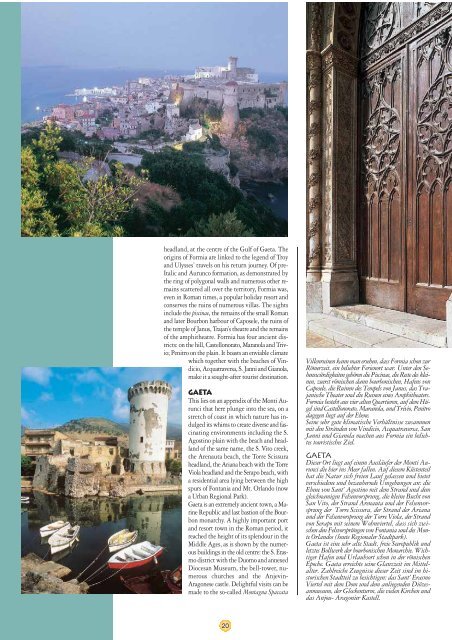Erfolgreiche ePaper selbst erstellen
Machen Sie aus Ihren PDF Publikationen ein blätterbares Flipbook mit unserer einzigartigen Google optimierten e-Paper Software.
headland, at the centre of the Gulf of Gaeta. The<br />
origins of Formia are linked to the legend of Troy<br />
and Ulysses’ travels on his return journey. Of pre-<br />
Italic and Aurunco formation, as demonstrated by<br />
the ring of polygonal walls and numerous other remains<br />
scattered all over the territory, Formia was,<br />
even in Roman times, a popular holiday resort and<br />
conserves the ruins of numerous villas. The sights<br />
include the piscinae, the remains of the small Roman<br />
and later Bourbon harbour of Caposele, the ruins of<br />
the temple of Janus, Trajan’s theatre and the remains<br />
of the amphitheatre. Formia has four ancient districts:<br />
on the hill, Castellonorato, Maranola and Trivio;<br />
Penitro on the plain. It boasts an enviable climate<br />
which together with the beaches of Vindicio,<br />
Acquatraversa, S. Janni and Gianola,<br />
make it a sought-after tourist destination.<br />
Gaeta<br />
This lies on an appendix of the <strong>Monti</strong> Aurunci<br />
that here plunge into the sea, on a<br />
stretch of coast in which nature has indulged<br />
its whims to create diverse and fascinating<br />
environments including the S.<br />
Agostino plain with the beach and headland<br />
of the same name, the S. Vito creek,<br />
the Arenauta beach, the Torre Scissura<br />
headland, the Ariana beach with the Torre<br />
Viola headland and the Serapo beach, with<br />
a residential area lying between the high<br />
spurs of Fontania and Mt. Orlando (now<br />
a Urban Regional Park).<br />
Gaeta is an extremely ancient town, a Marine<br />
Republic and last bastion of the Bourbon<br />
monarchy. A highly important port<br />
and resort town in the Roman period, it<br />
reached the height of its splendour in the<br />
Middle Ages, as is shown by the numerous<br />
buildings in the old centre: the S. Erasmo<br />
district with the Duomo and annexed<br />
Diocesan Museum, the bell-tower, numerous<br />
churches and the Anjevin-<br />
Aragonese castle. Delightful visits can be<br />
made to the so-called Montagna Spaccata<br />
Villenruinen kann man ersehen, dass Formia schon zur<br />
Römerzeit, ein beliebter Ferienort war. Unter den Sehenswürdigkeiten<br />
gehören die Piscinae, die Reste des kleinen,<br />
zuerst römischen dann bourbonischen, Hafens von<br />
Caposele, die Ruinen des Tempels von Janus, das Trajanische<br />
Theater und die Ruinen eines Amphitheaters.<br />
Formia besteht aus vier alten Quartieren, auf dem Hügel<br />
sind Castellonorato, Maranola, und Trivio, Penitro<br />
dagegen liegt auf der Ebene.<br />
Seine sehr gute klimatische Verhältnisse zusammen<br />
mit den Stränden von Vindicio, Acquatraversa, San<br />
Janni und Gianola machen aus Formia ein beliebtes<br />
touristisches Ziel.<br />
GAETA<br />
Dieser Ort liegt auf einem Ausläufer der <strong>Monti</strong> Aurunci<br />
die hier ins Meer fallen. Auf diesem Küstenteil<br />
hat die Natur sich freien Lauf gelassen und bietet<br />
verschiedene und bezaubernde Umgebungen an: die<br />
Ebene von Sant’ Agostino mit dem Strand und dem<br />
gleichnamigen Felsenvorsprung, die kleine Bucht von<br />
San Vito, der Strand Arenauta und der Felsenvorsprung<br />
der Torre Scissura, der Strand der Ariana<br />
und der Felsenvorsprung der Torre Viola, der Strand<br />
von Serapo mit seinem Wohnviertel, dass sich zwischen<br />
den Felsvorsprüngen von Fontania und des Monte<br />
Orlandos (heute Regionaler Stadtpark).<br />
Gaeta ist eine sehr alte Stadt, freie Seerepublik und<br />
letztes Bollwerk der bourbonischen Monarchie. Wichtiger<br />
Hafen und Urlaubsort schon in der römischen<br />
Epoche. Gaeta erreichte seine Glanzzeit im Mittelalter.<br />
Zahlreiche Zeugnisse dieser Zeit sind im historischen<br />
Stadtteil zu besichtigen: das Sant’ Erasmo<br />
Viertel mit dem Dom und dem anliegenden Diözesanmuseum,<br />
der Glockenturm, die vielen Kirchen und<br />
das Anjou- Aragonier Kastell.<br />
20

















